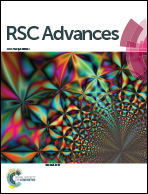Internally plasticized PVC materials via covalent attachment of aminated tung oil methyl ester
Abstract
We developed an internal plasticizer of aminated tung oil methyl ester for the production of non-migration, phthalate-free flexible and internally plasticized poly(vinyl chloride) (PVC) materials. The chemical structure of the synthesized aminated tung oil methyl ester and the internally plasticized PVC materials were characterized. The obtained internally plasticized PVC materials presented a lower glass transition temperature (Tg) and were more flexible than pure PVC. The thermal stability of internally plasticized PVC materials was less thermally stable compared to those of pure PVC due to the active secondary amine groups of aminated tung oil methyl ester. However, the modified PVC materials presented no migration for self-plasticizing PVC films but 15.7% weight loss for 50 wt% of the PVC/Dioctyl phthalate (DOP) system. It is expected that the PVC materials can be widely used in areas with high migration resistance requirements.



 Please wait while we load your content...
Please wait while we load your content...